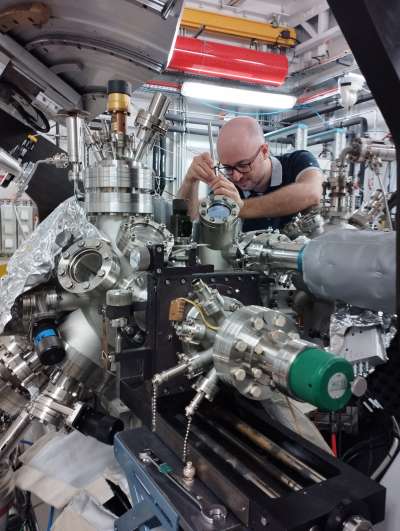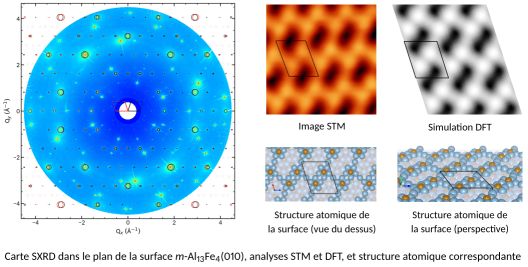Corentin Chatelier defended his thesis, entitled "On the surface structures and catalytic properties of aluminum-based intermetallics" on December 15, 2020. His work, carried out on the SIXS beamline and at the Jean Lamour institute in Nancy, was awarded twice: 2021 Thesis Prize from the University of Nancy and 2022 Thesis Prize from the French Association of Crystallography.
In this profile, find out more about his background, his experience as a doctoral student at SOLEIL and at the Jean Lamour Institute (IJL) and his scientific work.

His journey
After two years in physics and chemistry preparatory classes in Lyon, Corentin joins the École des Mines de Nancy in the materials department (physics of matter). For the first time that year, the department was offering a "research project" course, which allowed Corentin to spend one day a week for a year in Emilie Gaudry's team at the Jean Lamour Institute. During this project, Corentin works on X-ray surface diffraction data obtained at the ESRF, an exercise that he will reproduce during his thesis a few years later. He continues this analysis work in the laboratory of Roberto Felici at the European synchrotron ESRF on the ID03 beamline during a 2-month internship as an assistant engineer. This work leads to a scientific publication, Corentin's first. He then decides to go abroad for 2 years as part of a double degree between the School of Mines and the University of Alberta. He continues academic courses there but also did scientific research, this time in the field of metallurgy and alloys. After obtaining his degree in Materials Science and Engineering from the Ecole des Mines de Nancy and the University of Alberta, he decides to pursue a thesis.
Why a PhD ?
Having, at the end of his engineering school, always worked on results obtained at synchrotron facilities, Corentin wanted to do a thesis in one of these very large research facilities, to explore the experimental side.
“We are going all the way! From A to Z » - Corentin Chatelier
Intentions and motivation are great but to do a thesis you also need a subject, (at least) a host laboratory, and funding. Corentin contacts his former supervisor at the ESRF, Dr. Felici, to find out if it would be possible to prepare a thesis in his laboratory. Dr. Felici then redirects him to Alessandro Coati, head of the SIXS beamline at SOLEIL. And bingo! Alessandro is ready to embark on this project! Alessandro recalls: “Roberto Felici told me that he was a brilliant student, but that he could not offer him a thesis at this time. He highly recommended him. Our first meeting was a little special: it was via Skype, and Corentin was in a dark room in Edmonton, Alberta. The rapport was very easy and constructive. We then had a second interview with the team, to “test” Corentin. He was brilliant in his answers to the questions. Then I contacted Emilie Gaudry - she was his teacher and supervisor of his internship - who immediately wanted to set up a strong collaboration to work with Corentin. »
Co-funding for Corentin's thesis is obtained: on the one hand SOLEIL and on the other hand the Grand-Est region, for a 3-year doctorate. Thus, Corentin had barely finished his last year of engineering school on October 25, 2017, in Canada, that he arrived on November 1 at SOLEIL!
His thesis topic
The main theme of the thesis is to optimize materials for catalysis. Catalysis is the action of altering the rate or yield of a chemical reaction, either so that it occurs faster than it would naturally, or to produce one substance rather than another. A good example of catalysis in everyday life is the catalytic converter in cars. The pot is coated with platinum which allows the reaction between the oxygen in the air (O2) and the toxic gases produced by the engine: carbon monoxide (CO), nitrogen oxides (Nox), to produce harmless nitrogen (N2) and carbon dioxide (CO2) (apart from the contribution of CO2 to the greenhouse effect…).
During his thesis, Corentin studies compounds that could replace expensive and toxic catalysts such as platinum or palladium, which are widely used today. The compounds studied are intermetallic catalysts based on aluminum, i.e., alloys of aluminum and iron or cobalt. These metals are less expensive, abundant, and their extraction is less polluting than more conventional catalysts, which can (theoretically) be as effective as platinum.
Corentin explains that “Aluminum alone or cobalt alone does not work. You need very specific alloys with a very specific electronic structure* on the surface”.
Indeed, in an alloy, the combination of aluminum and iron (Al13Fe4) forms flower-shaped surface patterns with two pentagons of aluminum each surrounding an isolated iron atom (see Figure 1). The aluminum and iron atoms pool their electrons and the iron acts as an interesting adsorption site for molecules of butadiene (C4H6)
“When you mix aluminum and iron in particular proportions, a particular structure, a particular pattern is formed. And we thought, why not use that for the catalysis of hydrogenation of butadiene! And it worked! That’s research, we test for things, and we discover new mechanisms or structures”.
The goal of his thesis was to understand how this catalysis takes place: where are the atoms, what are the reaction mechanisms, the movements of the atoms. To do so, Corentin uses the surface diffraction of X-rays on SIXS to know the position of the atoms, then carries out quantum chemistry calculations by mathematically modeling the interaction of electrons between all the atoms to know the electronic structure of the sample.

His works
Corentin, along with the scientists from the SIXS beamline and the IJL team, tests his catalysts in the context of hydrogenation reactions: the chemical reaction between molecules of hydrogen H2 and, here, molecules of butadiene (C4H6). During these reactions, the initial molecules will interact, exchange electrons, to form new molecules. The surface of the catalyst will make it possible to promote this interaction and these exchanges between the molecules of reagents, and in this case the synthesis of molecules of butene - or else of butane if the catalyst is less selective.
“Chemistry is sharing!” - Corentin Chatelier
Because the catalysis reaction takes place on the surface of the catalyst, this is where you must look. Therefore, Corentin uses SIXS. The beamline is equipped with a grazing incidence diffractometer, i.e., the light, X-rays, will graze the material. Thus, the diffraction signal obtained, which corresponds to the “response” of the sample studied to the X-rays it receives, is almost solely due to its surface, and not to its deeper layers of atoms – therefore where the catalytic reaction takes place. In addition, SOLEIL's X-ray beam is very bright, i.e., the amount of synchrotron radiation photons is very high, which allows for very good resolution. Indeed, the signal (given by the sample studied) to noise ratio is much better than with a laboratory X-ray source. The research work carried out during this thesis provides new knowledge on the surface structures and the adsorption and catalysis properties of certain aluminum-based intermetallics.
We asked Corentin about the potential future applications of his thesis work: "Well the application, if we want to be very optimistic, would be to use the catalysts that I have characterized on a large scale but, in reality, it is not really possible because my catalysts are model systems... So, my work has above all made it possible to set up a characterization methodology that can be used by other scientists (to identify new catalysts, editor’s note). " And, to conclude: “In fundamental research, what is interesting is to understand things and not necessarily why or how to use them”.
Corentin wrote his thesis during the pandemic, unfortunately himself suffering from COVID-19... It was a difficult period that he nevertheless overcomes brilliantly as he defends his thesis on December 15, 2020 and is awarded the title of doctor in materials sciences from the University of Lorraine. This thesis work also gives rise to 4 scientific publications in 3 years!
“12 synchrotron experiments in 3 years, the use of national computer clusters for the equivalent of 3 million hours of calculation… We worked a lot! »
Supported by his doctoral school director (C2MP - Mechanical Chemistry Materials Physics, University of Lorraine) who was impressed by his work, Corentin applies and obtains the 2021 thesis prize from the University of Lorraine. Then the French Association of Crystallography awarded him the 2022 thesis prize.
"It's a bit of a pride to say to yourself "even if you're not well, you can manage to do great things!"
What about now?
After his thesis, Corentin went straight to his post-doctorate, which began a month after his thesis defense!
Corentin is now an engineer and post-doctoral researcher at the Interdisciplinary Research Institute of Grenoble, Materials Modeling and Exploration Department, Nanostructures and Synchrotron Radiation Laboratory, in collaboration with the ID01 beamline of the ESRF, and he continues his collaboration with Alessandro Coati and the SIXS beamline team by continuing to study catalysts, this time using an imaging technique that exploits the coherence of X-rays, but that's another story...
“It is always a pleasure to work with Corentin. He has acquired a lot of new skills, particularly in coherent diffraction, and this allows us to discover together this new technique that we have started to implement on SIXS thanks to Andrea Resta (beamline scientist on SIXS - Editor's note) and the rest of the team.” explains Alessandro.
For his future, Corentin would like to continue research and why not become a beamline scientist in a synchrotron like SOLEIL but, for the moment, he is still following a superb path! At the end of August 2022, during the ECM33 conference, he obtained the Poster Prize "Applied Crystallography" from the International Union of Crystallography for his post-doctoral work!
*electronic structure: distribution of an atom’s electrons around its nucleus.
